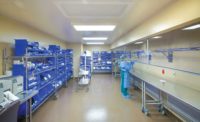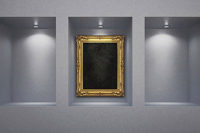At Walter Reed Military Medical Center, the mission was an air distribution overhaul of the surgical operating room suites without interrupting the ongoing delivery of care. The project team designed and delivered an upgraded environment in each new OR using a new desiccant-based system and custom air handlers. The result was increased environment flexibility and safety in the surgical suites, and more.
The Why Behind the Way
The statistics are sobering. Approximately 99,000 deaths are reported each year in the United States from Health Care Acquired Infections (HAI), according to the Centers for Disease Control. By definition, an HAI occurs when a patient develops an infection he did not have prior to being inside the health care environment. Thirteen percent of these fatalities result from a Surgical Site Infection (SSI), which involve the building Operating Room environment including its HVAC system. Some estimate that 10-20% of SSIs are acquired as airborne infections carried through the duct system or caused by HVAC distribution. Regardless of the exact numbers, it is clear that due diligence must be paid when designing and installing Operating Rooms (ORs) and their support systems.
Design-Build of Medical HVAC, Plumbing, and Medical Gas Systems
Around 2007, the conditions of the existing Walter Reed Army Medical Center in Washington began to attract the public’s attention due to the deteriorated condition of many of the facilities. As a result, a project was developed to add to and renovate the existing National Naval Medical Center in Bethesda, MD. The expanded and renovated facility was renamed the Walter Reed National Military Medical Center (WRNMMC). The project was managed by the Naval Facilities Engineering Command (NAVFAC) and was part of the Base Realignment and Closure (BRAC) program initiated by the Department of Defense.
The overall project included the construction of two new buildings that bracketed the iconic center tower and were designed to match the historic façade. Renovation of the existing hospital facility included the installation of three new and renovation of 18 existing OR within the surgical suites area. The size of the existing ORs was increased to meet industry standards and the finished project now contains two state of the art ORs.
The design/build team, well aware of the critical nature and challenges of this portion of the project, took considerable care to select the most appropriate technical solution that would help ensure a world-class facility as the end result.
The surgical suite renovation process included installation of new custom air handling units (AHUs) using an active, dry desiccant system that was installed to condition the ORs. A desiccant is a substance that has an affinity for moisture. In this case, a solid silica gel desiccant, applied to a rotating ceramic wheel, was located between the supply air to the ORs and an outside airstream. As the wheel rotates through the mixed return air and outside air, steam water vapor is absorbed by the desiccant. A separate outside airstream, referred to as “scavenger” air, is first heated, in this case by steam coils using high pressure 125 psig steam. The hot dry air then captures water vapor as it passes through the desiccant wheel. Then, the hot moist scavenger airstream is discharged to the outside ambient. From each AHU to the surgery suite and back, the entire process is dry. No moisture condenses anywhere in the system.
After the moisture in the supply airstream is removed, the air is warm, but dry. The warm supply air is then cooled down to a “load neutral” state of approximately 75°F by a past cooling coil. The dry condition of the supply air alleviates any concern about moisture in the ductwork. New custom AHUs that house the wheels, cooling coils, and other components were installed in a new penthouse on top of the existing hospital. The AHU’s were connected to a common duct manifold to provide redundancy in the event that one unit may need to be taken off line for maintenance.
A traditional HVAC design would first cool and dehumidify the AHU supply air stream to a temperature low enough to satisfy the worst case cooling load in any of the ORs. Rooms not requiring this low supply air temperature to satisfy their cooling load demand would include a duct-mounted zone reheat coil to elevate the supply air temperature back up again.
In the WRNMMC project, the air distribution approach instead delivers dry “load neutral” approximately 75°F air to zone cooling coils. The supply air distribution for each OR has a uses zone chilled water coil in the duct branch serving the room. The OR staff can then choose a space temperature anywhere between 60°F-75°F. Each duct-mounted cooling coil provides sensible cooling only, and therefore no condensation occurs on the coil. With the HVAC approach used, the traditional global cooling and subsequent zone reheat, consuming significant energy, is eliminated. Most importantly, the opportunity for moisture condensation throughout the air distribution system has been removed. Also, even within an OR maintained at a 60°F space temperature, the space relative humidity remains well below 60% RH.
During cold winter conditions, moisture must be added to ensure the room minimum relative humidity is maintained. The traditional design approach includes a trim steam humidifier for each zone. The humidifier is typically installed downstream of each zone hot water coil. Under certain psychrometric conditions, this can be problematic given the high air velocity and cold temperature of the air. In contrast for the WRNMMC OR suite renovation project, humidification is added centrally, inside the AHU. This approach offers two main benefits that address the concern regarding excess moisture inside the duct system:
1. The air velocity is much lower as compared to the duct location.
2. The air is warmer at 75°F versus the traditional supply air temperature of 55°F or lower.
The warmer temperature and relatively slower airstream velocity within the AHU allows the moisture to be more readily absorbed.
Overcoming Critical Issues
One of the more challenging aspects in renovating the main Operating Rooms suite at this major medical facility was doing so while active surgeries were continually occurring directly adjacent to the work zone. Whenever construction work is performed within an operating health care facility, a properly designed and implemented Infection Control Risk Assessment (ICRA) program must be in place. Construction activity with the potential for creating dust is a particular concern. This is especially true when demolition and new construction work is occurring immediately adjacent to an OR where, for example, open heart surgery is in progress. The design/build team for this project, along with NAVFAC and hospital facility representatives, worked closely as a team in maintaining an ICRA plan that ensured that at least seven ORs within the suite were available and ready for use 24/7.
One important aspect of the project ICRA plan involved the installation of the temporary construction barriers separating construction zones from active ORs, surgical corridors, and other surgery support spaces. The temporary barriers, extending slab to slab, required that the penetrations of numerous ducts, pipes, conduits, medical gas lines, and other support systems through them be carefully sealed air tight. Then, temporary exhaust fans and HEPA filtration units were frequently employed at the barrier zones to maintain the safe IAQ conditions at adjacent active area boundaries.
Another project challenge was that the new AHUs and duct air distribution systems required installation while existing systems remained in service and fully functional long enough to support the on-going surgical suite operations. Adequate space and clearance was not available in the existing ceiling plenums to install the new duct systems adjacent to existing systems. This required that new large round supply and return air duct systems be installed and supported above the roof — extending to and from from the AHUs located in a new penthouse equipment room above the locations of the ORs.
The installation, insulation, and jacketing of this new duct system was critical. It was designed to ensure that the condition of the supply air did not deteriorate during extreme outdoor ambient conditions. The round ductwork was also beneficial as it prevents the accumulation of rain and snow on top of the ducts. After options for the most robust, long-lasting insulation and jacketing solutions were thoroughly investigated, the selected closed cell type insulation and associated jacketing system included a field-applied five-ply adhesive material providing essentially zero vapor permeability.
The Results
Despite the numerous challenges involved, including working in and around the complex active working environment and on an accelerated schedule, the project was a huge success. The interior space conditions are constantly monitored and tightly maintained via use of the facility energy management and control system (EMCS). A psychrometric plot of a typical summer design day was created with actual recorded condition (Figure 4). The plot illustrates that desired conditions were successfully maintained within the target psychrometric region for the OR. The EMCS allows OR staff to select the desired space temperature for any type of surgery. Room temperature selections have been selected for and maintained as low as 60°F. Regardless of the space temperature selected, each OR’s relative humidity is always maintained within the maximum and minimum boundaries recommended by ANSI/ASHRAE Standard 170-2013.
Since the entire air delivery process from the AHUs through the ductwork is dry, the risk of moisture and biological growth from origin to delivery through the diffusers has essentially been eliminated. The project has provided NAVFAC with a world class operating rooms facility. The new sterile environment offers our military community the opportunity for very successful surgical outcomes and significantly minimizes the risk of acquiring HVAC-related surgical site infections within an OR.
In The OR, Good IAQ = Good Outcomes
Numerous aspects of an HVAC system can contribute to a less than desirable OR environment, most notably moisture and space conditions.
Moisture in unwanted (especially cold, dark, high humidity) locations can support the growth of mold or other biological substances. Minimizing the opportunity for mold and biological growth is a primary goal in areas where invasive procedures are being performed. Examples of locations where the potential for moisture formation can occur are provided below.
• Condensate Drain Pans. Water vapor in the air passing over a cooling coil condenses with the intent that water is collected in a drain pan and ultimately piped away. Standing water, however, in drain pans is a prime location for biological growth.
• Saturated Supply Air. In traditional designs, air leaving cooling coil is completely saturated with moisture. If this cold air accelerates over objects such as filters or turning vanes, the water vapor can condense out of the airstream and collect in pockets and ductwork seams. Final or HEPA filters receiving saturated air, especially with blow-through AHU configurations, provide opportunities for localized moisture condensation to occur.
• Trim Humidifiers. Traditional designs include a duct mounted humidifier to control the OR room relative humidity during dry winter periods. If not properly maintained, these humidifiers can supply excess moisture that can collect inside the duct system and provide a location for biological growth.
• Supply Air Outlets. If there is enough latent heat gain inside the OR from the personnel or procedures involved, the room dew point temperature can elevate above the supply air temperature, causing condensation on the supply air outlets and potential of water dripping into the treatment area.
In addition to the risks of moisture-driven biological growth, the OR space conditions are crucial to successful outcomes. ASHRAE/ASHE Standard 170 is the generally accepted design standard for ORs. The required conditions for a Class A operating room environment are stated as:
- Temperature– 68-75°F
- Relative Humidity– 20-60%
• Desired Conditions. The Standard indicates that some surgeons or surgical procedures may require temperatures lower than 68°F. In fact, requests for dry bulb space temperatures as low as 55°F are not unusual. If a traditional HVAC system is used to generate these conditions, it likely will not achieve the desired temperature; and if it does, the moisture level in the room will be elevated, causing the room to be clammy and uncomfortable.
• OR Staff Productivity. Some procedures require extensive gowning and long hours. It is common to keep the room as cool as possible to keep the staff productive and alert.
• Microsurgery. Robotic equipment is increasing in use, and typically requires cold and dry conditions to ensure condensation within the unit does not occur and optics remain clear.
• Perspiration. Studies have shown that perspiring surgeons increase the likelihood of contamination in the surgical field.
Curt Eisenhower is Principal Engineer at Southland Industries. He can be reached at 703.834.2424 or CEisenhower@southlandind.com.




